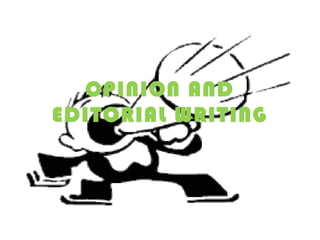
Opinion and editorial writing
- 2. OPINION WRITING The opinion is a piece of writing that expresses the personal belief of the writer about timely issues. It is supported by facts. It regularly appears each issue under the same title and at the same location on the page. Opinions are regular features on the editorial page but they also appear in the feature page, science page, sports page and even in the front page.
- 3. Parts of Editorial 1)INTRODUCTION 2)THE BODY 3)THE CONCLUSION
- 4. INTRODUCTION - it is the beginning paragraph. It may contain the news upon which the editorial is based. In which case, the introduction is called the news peg. In some cases, the introduction states outright the stand of the editorial.
- 5. THE LEAD- is also placed in the introduction to keep the readers reading on. It can take many forms as follows: • A simple statement that gives enough of the situation, problem or news event • A striking statement which arrests the reader’s attention • A question with which you can invite attention to the problem or situation to be discussed • A narrative illustrating the problem or situation
- 6. 2) THE BODY-It contains the facts about the news or issues including the writer’s opinion or viewpoints. It builds up the case through a logical order and is supported by facts. It may be made up of three to four paragraphs. * Use examples and illustrations *Quote sources and authorities * Cite statistics if applicable * Use formal language * If you are presenting a number of arguments to support your stand, start with the most powerful.
- 7. 3) CONCLUSION-This is the last part that either summarizes or drives home the point. It ties up the ideas and arguments presented in the body. The conclusion may be written in the form of: *A SUGGESTION e.g. The business sector would do well to evaluate people on the basis of merit rather than the academic degree. * A CHALLENGE e.g. If other schools can develop a culture of excellence, why can’t we? * ROUNDING UP OR SIMPLE SUMMARY e.g. The spate of scandals over government deals, characterized by favoritism and influence peddling, marks the government claims of transparency. Worse, it undermines the chances of the Philippines to recover from economic crisis.
- 8. Steps in writing opinion: *Open with a grabber. *Lay out your thesis in the first paragraph. * Demonstrate how widely held your opinion is, * Explain why you and many others feel the way you do. * Cite the opinions of experts who agree with you. *If one exists, include a celebrity angle. * Make your opinion relate to the experience of ordinary people. * Examine the “BIG PICTURE”. * Leave a lasting impression by offering a forward-looking prediction or rhetorical question.
- 9. EDITORIAL WRITING An editorial is an expression of facts and opinions in concise or an analytical interpretation of significant and timely topics or issues. It is logical and pleasing in order to influence opinion, or to interpret significant news such that its importance to the reader will be clear. It is usually written in formal language. Through editorial, the paper has the opportunity to write what it thinks about issues affecting the readers. If the editorial is well- written; it can be a vital force to make changes and reforms.
- 10. DIFFERENCE BETWEEN AN EDITORIAL TO COLUMN AND OPINION WRITING Editorial is the collective point of view of the staff of the paper on a certain issue. In essence, it is the paper’s stand on the issue and the paper represents everyone in its staff. Hence, no editorial is written from the first person singular point of view: I, my, mine. It may take the first person plural point of view (We, us, ours, our), the second person and the third person point of view.
- 11. Who writes the Editorial? The whole staff chooses a topic based on the news events, discusses the issue extensively and gathers and organizes the data. The best writer in the staff writes the editorial, seeing to it that the important ideas of the group are incorporated in the piece. Therefore the editorial is the stand of the staff or the paper on a certain issue.
- 12. CHARACTERISTICS OF AN EDITORIAL * Editorial must be interesting, compelling and concise. *Editorial must be factual and provide pertinent information. * It must be concise, around 250-300 words in four or five paragraphs.
- 13. Types of Editorial 1) EDITORIAL OF INTERPRETATION- it tries to interpret meaning of news by merely presenting both sides of an issue, event or situations and leaves the judgment to the reader. 2) EDITORIAL CRITICISM-it points out the faults in the situation mentioned in a news that concerns and interests readers. It uses a scientific method by defining the problem, examining the evidence available and then perhaps suggests a solution.
- 14. 3) EDITORIAL OF ARGUMENTATION OR PERSUASION- it takes a stand in a controversial issue and tries to convince the reader to adopt this stand. 4) EDITORIAL OF COMMENDATION, COMMENDATION OR TRIBUTE- It gives praise to a worthy deed done by a person or by an institution. 5) EDITORIAL OF ENTERTAINMENT- it discusses issues lightly, but often has a serious point gently and subtly suggested and sometimes satirically. 6) CRUSADE EDITORIAL-it usually endorses a thought or course of action. This is also called a campaign editorial.
- 15. STEPS IN WRITING THE EDITORIAL *Choose a very timely topic. *Be clear about the type of editorial you ill write and also the purpose. *Be sure you know and understand the topic well. Formulate your stand or position. * Gather sufficient data. *Write…write…write
